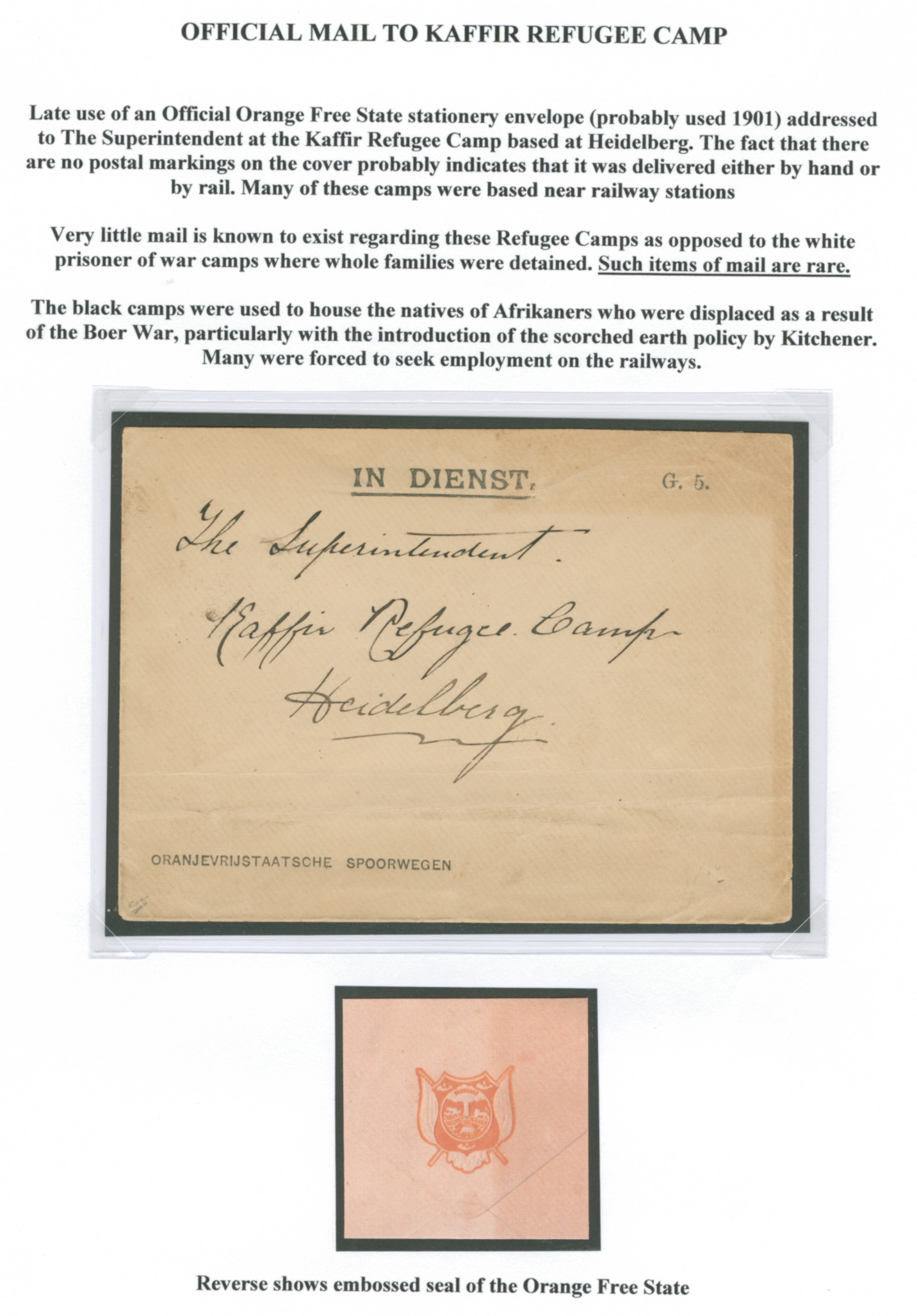Comment on 'K is for....'
Quote from Underbidder on June 14, 2021, 3:06 pmWith reference to Steve's 'K is for ....', I attach the following. It should need no explanation but for those not familiar with the ABW, a 'Kaffir Refugee Camp' was a place for displaced Black South Africans.
With reference to Steve's 'K is for ....', I attach the following. It should need no explanation but for those not familiar with the ABW, a 'Kaffir Refugee Camp' was a place for displaced Black South Africans.
Uploaded files:Quote from Steve on June 14, 2021, 3:26 pmA very nice 'K' cover. Thank you.
However, I have two 'issues' with the write-up. First, there were very few POW Camps in SA other than Green Point and Bellevue in Simonstown. Most South African 'POW' canps were temporary holding pens for the shipment of irreconcilable Boer POWS overseas. This transporatation of Boers was based on the great and real British fear of insurrection by Cape Dutch rebels sympathetic to the Boer republican cause. The British worried that POW camps in SA were not safeefrom being overrun by Boer guerilla commandos. As a result, all captured ZAR and OFS combatants were shipped to POW camps overseas in places like St Helena, Bermuda and Ceylon.
However, Underbidder's description of the Refugee Camps as 'white POW camps' is appropriate. However, these women, children and old men were not combatants. They were civilians forcibly removed from their homes and farms by the British Army. The British believed these peoiple were providing succour to Boer commandos active in the field. They were held forcibly in these camps against their will. You can make a strong case for arguing that these women, childreren and old men were POWs, not refugees.
After the British had dynamited and burned their farms and bayonetted the livestock, the now destitute and forcibly 'displaced' Boer women, children and old men were marched off to so-called 'Refugee Camps'. They were not refugees throwing themselves on the mercy and kindness of strangers. They were civilians whose lives had been destroyed for tactical military reasons by the British Army. By calling them 'refugees' the British hoped to deflect some of their guilt for what is today a war crime. These Boer 'refugees' would have preferred to have stayed in their homes (and keep on supplying the commandos) rather than see them destroyed by the British Army's scorched earth policy. After that they had to endure watching almost half of all Boer children in the Concentration Camps die.
Almost as many Black people were also housed in so-called 'Refugee Camps' as Boers. This cover is proof of that. Some of the Black 'refugees' came from the farms that the British had destroyed. Deprived of work and food they had a stronger claim to refugee status. However, many of the Black people in the 'Refugee Camps' were also small farmers and others whom the British had rounded simply because they needed labour to build military defences like blockhouses and miles of barbed wire fences. Black refugee camps were less POW camps and more labour concentration camps. For a variety of reasons, Black people had a better survival rate in these camps.
Under Kitchener the British Army initiated a 'scorched earth' policy which concentrated the dislocated in 'Refugee Camps'. The British Army turned a blind eye to the ensuing sickness in the 'Refugee Camps' and acted coldly with callous indifference to the spiralling death rate. The victims were called 'dirty Boers'. The 'Refugee |Camp' was one of the 20th Century's great acts of cynical misnomering and guilt deflection. The death rate in these camps eventually gave the lie to the euphemism and finally the world got to know them for what they were, death camps run by a heartless, jingoistic British military regime. Only the intervention of Emily Hobhouse, a British anti-war activist concerned with the welfare of people generally, saved these unfortunate 'refugees' from extinction.
The arch-imperialist Alfred Milner, the South African High Commissioner, dismissed Hobhouse as a Boer sympathiser and "trouble maker". Ignoring Milner, Hobhouse proceeded to publicise the distress of the camp inmates and managed to speak to Henry Campbell-Bannerman, the Liberal opposition party leader. The Conservative Secretary of State for War, St John Brodrick, defended the British Army's tactics arguing that the camps were purely "voluntary", that the interned Boers were "contented and comfortable". When this lie was disproven he argued "military necessities", saying that everything possible was being done to ensure satisfactory conditions in the camps. In June 1901, Hobhouse published a report that contradicted Brodrick's bald claim.
Lloyd George now openly accused the government of "a policy of extermination" directed against the Boer population. The same month, Campbell-Bannerman gave a speech criticising British scorched earth methods and the internment of civilians. He asked "When is a war, not a war? When it is carried on by methods of barbarism in South Africa". The Hobhouse Report caused an uproar both domestically and internationally. By August 1901,while official reports occasionally continued to reference "camps of refuge," the term "concentration camps" had become the standard descriptor amid growing public awareness of the high mortality rates.
A very nice 'K' cover. Thank you.
However, I have two 'issues' with the write-up. First, there were very few POW Camps in SA other than Green Point and Bellevue in Simonstown. Most South African 'POW' canps were temporary holding pens for the shipment of irreconcilable Boer POWS overseas. This transporatation of Boers was based on the great and real British fear of insurrection by Cape Dutch rebels sympathetic to the Boer republican cause. The British worried that POW camps in SA were not safeefrom being overrun by Boer guerilla commandos. As a result, all captured ZAR and OFS combatants were shipped to POW camps overseas in places like St Helena, Bermuda and Ceylon.
However, Underbidder's description of the Refugee Camps as 'white POW camps' is appropriate. However, these women, children and old men were not combatants. They were civilians forcibly removed from their homes and farms by the British Army. The British believed these peoiple were providing succour to Boer commandos active in the field. They were held forcibly in these camps against their will. You can make a strong case for arguing that these women, childreren and old men were POWs, not refugees.
After the British had dynamited and burned their farms and bayonetted the livestock, the now destitute and forcibly 'displaced' Boer women, children and old men were marched off to so-called 'Refugee Camps'. They were not refugees throwing themselves on the mercy and kindness of strangers. They were civilians whose lives had been destroyed for tactical military reasons by the British Army. By calling them 'refugees' the British hoped to deflect some of their guilt for what is today a war crime. These Boer 'refugees' would have preferred to have stayed in their homes (and keep on supplying the commandos) rather than see them destroyed by the British Army's scorched earth policy. After that they had to endure watching almost half of all Boer children in the Concentration Camps die.
Almost as many Black people were also housed in so-called 'Refugee Camps' as Boers. This cover is proof of that. Some of the Black 'refugees' came from the farms that the British had destroyed. Deprived of work and food they had a stronger claim to refugee status. However, many of the Black people in the 'Refugee Camps' were also small farmers and others whom the British had rounded simply because they needed labour to build military defences like blockhouses and miles of barbed wire fences. Black refugee camps were less POW camps and more labour concentration camps. For a variety of reasons, Black people had a better survival rate in these camps.
Under Kitchener the British Army initiated a 'scorched earth' policy which concentrated the dislocated in 'Refugee Camps'. The British Army turned a blind eye to the ensuing sickness in the 'Refugee Camps' and acted coldly with callous indifference to the spiralling death rate. The victims were called 'dirty Boers'. The 'Refugee |Camp' was one of the 20th Century's great acts of cynical misnomering and guilt deflection. The death rate in these camps eventually gave the lie to the euphemism and finally the world got to know them for what they were, death camps run by a heartless, jingoistic British military regime. Only the intervention of Emily Hobhouse, a British anti-war activist concerned with the welfare of people generally, saved these unfortunate 'refugees' from extinction.
The arch-imperialist Alfred Milner, the South African High Commissioner, dismissed Hobhouse as a Boer sympathiser and "trouble maker". Ignoring Milner, Hobhouse proceeded to publicise the distress of the camp inmates and managed to speak to Henry Campbell-Bannerman, the Liberal opposition party leader. The Conservative Secretary of State for War, St John Brodrick, defended the British Army's tactics arguing that the camps were purely "voluntary", that the interned Boers were "contented and comfortable". When this lie was disproven he argued "military necessities", saying that everything possible was being done to ensure satisfactory conditions in the camps. In June 1901, Hobhouse published a report that contradicted Brodrick's bald claim.
Lloyd George now openly accused the government of "a policy of extermination" directed against the Boer population. The same month, Campbell-Bannerman gave a speech criticising British scorched earth methods and the internment of civilians. He asked "When is a war, not a war? When it is carried on by methods of barbarism in South Africa". The Hobhouse Report caused an uproar both domestically and internationally. By August 1901,while official reports occasionally continued to reference "camps of refuge," the term "concentration camps" had become the standard descriptor amid growing public awareness of the high mortality rates.
Quote from Jamie Smith on June 14, 2021, 3:42 pmHistorical! But love the cover.
Historical! But love the cover.

